Combining new buildings with the historic pre-existing environment
Among the various architectural projects by Reiulf Ramstad Arkitekter, the one for the residential complex Pilestredet 77-79 wins several architecture awards: Architizer A+Awards Jury Winner | Multi Unit Housing Low Rise; Murverksprisen; AIA International Region 2020 Design Awards; Nomination to Mies van der Rohe Award. The project's goal is to combine new buildings with the historic pre-existing environment of the Fagerborg neighborhood in an innovative and attractive way













